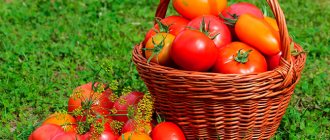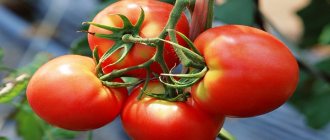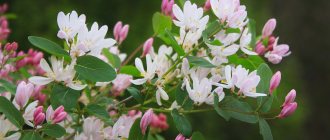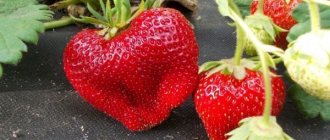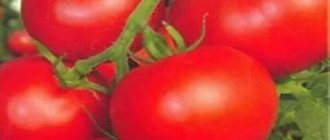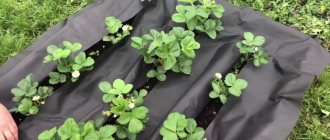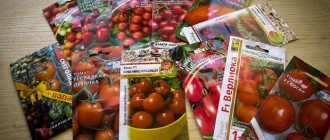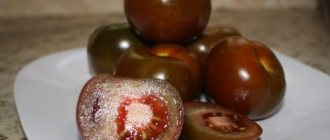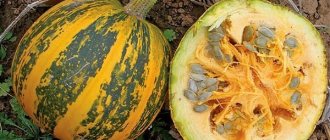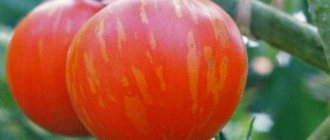Tomato cladosporiosis is a serious disease that can cause considerable damage to your tomato crop. One way to solve this problem is to grow varieties resistant to this disease.
This disease is otherwise called brown leaf spot of tomato or leaf mold. Cladosporiosis of tomato develops due to the influence of the fungus Cladosporium fulvum Cooke on the vegetable crop. As a result, light green or yellow-green spots appear on the leaves without a clearly defined border. In this case, on the underside of the leaf, the spots are covered with a velvety gray-white coating, which subsequently changes color to yellow-brown or green-brown. The disease first affects the lower leaves, then gradually spreads up the plant. The affected areas of the plant die. If measures are not taken in time to eliminate the disease, the leaves will begin to dry out and fall off, and convex, hard olive-colored spots with a dark coating will appear on the fruits.
Cladosporiosis of tomato is especially common when growing crops in winter greenhouses, since it develops well at air humidity of about 90%. Temperatures above 22°C contribute to the accumulation of infection, but infection can also occur at lower temperatures. However, authoritative sources claim that at a humidity of 60%, which is considered optimal for tomato growth, infection does not occur.
There are a number of tomato varieties and hybrids that are quite resistant to brown leaf spot. Let's list some of them.
Tomato Sun
Mid-early tall variety. From the emergence of seedlings to fruiting, 102-108 days pass. Seeds for seedlings are sown in late February - early March. The variety is intended for cultivation in film and glazed greenhouses and film tunnels. It is recommended to plant seedlings in late April - early May at the age of 50-55 days. The yield is 8-9 kg per 1 sq.m. The fruits are smooth, round in shape, weigh 60-70 g, and are suitable for fresh consumption or for canning whole. Tomato is classified as indeterminate.
- Sunshine in the garden: the best varieties of yellow and orange tomatoes
Many gardeners like their beds to be not only productive, but also elegant - bright tomatoes are perfect for this!
Symptoms of the disease
Typically, an outbreak of cladosporiosis is observed in the middle of the vegetative development of tomato bushes, during flowering and the formation of fruit ovaries. First, the disease affects the lower part of the bush. Very quickly the fungus reaches the apical organs of the bush, and all the leaves are already affected.
The main signs of brown spot:
- On the lower leaves, the outer side of the leaf blades is covered with yellow-green, dirty spots of various sizes and shapes. Then their color becomes brown, brown with a yellow border.
- On the back of the leaves, on the spots that appear, you can notice a whitish “terry” coating of light green, olive color. Over time, this color changes to brown, gradually reaching almost black - this is a sign of maturation of fungal spores.
As the disease develops, it affects not only foliage, but also flowers, petioles, and ovaries. Ugly brownish-yellow stains also appear on them, on which a coating of fungal sprouting becomes visible over time.
Without treatment, diseased leaves dry out, their structure, shape, elasticity, and color change. A couple of weeks after the painful spores appear, the foliage completely dies and falls off. When leaves fall, the process of photosynthesis is disrupted, which leads to the gradual death of the entire plant.
The disease usually does not affect the fruits and stems, but they die off on their own due to lack of nutrients. True, only small tomatoes can become covered with spores, which quickly turn brown, wrinkle and fall off.
Tomato Seven
Mid-season variety, bush height - 1.5-2 m. 111-115 days pass from emergence to fruiting. Seeds for seedlings are sown in early to mid-April. Planting seedlings in open ground - in early to mid-May or late May - early June at the age of 30-35 days. The variety is recommended for cultivation in film greenhouses, tunnels and open ground. The yield is 10-11 kg per 1 sq.m. The round fruits weigh up to 160 g and are suitable for raw consumption and canning. Tomato is classified as indeterminate.
Tomato varieties resistant to brown spot and late blight
The dream of every summer resident is to grow and preserve a good harvest. But this is not always possible: weather conditions, various diseases, pests - all this prevents plants from growing and bearing fruit normally.
One of these enemies is late blight, a dangerous fungus that can significantly reduce, and sometimes destroy, the entire crop. Therefore, tomato varieties for greenhouses that are resistant to late blight will be of great interest to all tomato growers.
What is late blight: causes and signs of appearance, why it is dangerous
Late blight is a fungal disease that affects crops of the nightshade family. Tomatoes, peppers, potatoes, and eggplants affected by this fungus quickly become sick and die. This disease is especially dangerous in enclosed spaces.
Appearing on the lower leaves in the form of a white coating, the infection quickly covers new areas of the stems, leaves, and also affects the fruits.
Brown spots appear on them, the fruits dry out and rot. Both ripe and green tomatoes are infected. The disease develops very quickly.
Causes of late blight
- Growing tomatoes in a greenhouse for several years in a row without changing the soil, as well as planting them after potatoes in one area.
- Since late blight first attacks potatoes, tomatoes need to be planted at a considerable distance from the potatoes.
- Another reason is densely planted plants and lack of ventilation in the greenhouse.
- Improper watering (water gets on the leaves), damp, cool environment.
- More often, the disease appears on plants receiving excess nitrogen fertilizers.
Variety selection criteria
When choosing varieties to plant on their site, most gardeners are guided by the following characteristics:
- productivity,
- frost resistance,
- taste qualities,
- resistance to diseases,
- specifics of consumption.
Determinate and indeterminate varieties: which are more resistant to disease?
Determinate varieties are varieties that are limited in growth and are shorter in stature. They have faster ripening times and are very good for canning.
Indeterminate varieties are tall, productive, and unpretentious to weather conditions. It must be said that these tomatoes are also more resistant to late blight and other diseases.
Both types of tomatoes can be grown in a greenhouse. Each type has its own distinct characteristics.
Much when choosing depends on climatic conditions and the size of the greenhouse.
"Persimmon" - the most resistant variety: overview of characteristics, features
The variety is determinate, low-growing, and was developed relatively recently. This is one of the hybrid varieties, reminiscent of persimmon in shape and color, which is why it got its name.
One of the main advantages is its large fruit size; some fruits can reach up to 500 g.
- the bush has a height of up to 80 cm, in a greenhouse up to 100 cm;
- tender juicy pulp, orange in color;
- the taste is pleasant, sweet, few seeds;
- has universal consumption;
- well stored, transportable;
- The variety requires care.
If we talk about susceptibility to diseases, then Persimmon has poor resistance to diseases, especially late blight.
The most popular varieties resistant to late blight: TOP-10
Some varieties are best known among summer residents who plant tomatoes in a greenhouse. They are resistant to late blight and have excellent characteristics.
Gardener
A universal determinate variety, it needs pinching, tying, and bush formation. Has good immunity to various diseases.
- Salad variety.
- It has an excellent taste, the fruits are dense, fleshy, sweet, bright red.
- There are few seeds, the skin is smooth and dense.
- It is stored for a long time and tolerates transportation well.
- The fruit weight is from 250 to 300 g, but if you remove several ovaries from the cluster and leave 5-6 pieces, you can achieve larger fruits.
- The height of the bush is from 60 cm in open ground to 150 cm under film.
- Productivity in a greenhouse is up to 11-14 kg per 1 sq.m.
Gypsy
Medium ripening variety for salad purposes. The fruits have a sweet taste with a slight sourness. In the greenhouse the bushes grow and become tall.
The plant is resistant to diseases.
- The unusual color is dark pink; ripe fruits are chocolate.
- Fruit weight - from 100 to 180 g.
- The bush is small in height, reaching up to 1.2 m.
- The skin is thin, the flesh is juicy and dense.
- Stores well and can be transported over short distances.
Academician Sakharov
The variety is tall, indeterminate, mid-season. In a greenhouse it can reach a height of more than 2 m. The variety is salad, the tomatoes are very large, round in shape. Very resistant to diseases, not afraid of late blight.
- It bears fruit for a very long time, in the greenhouse until September.
- Very productive, up to 12 kg of fruit can be harvested from one plant.
- Excellent taste, fleshy and juicy flesh.
- The bush needs shaping, gartering, and removal of stepsons.
- Ripe fruits are bright red and sweet.
Soyuz 8 F1
An early-ripening hybrid determinate variety, excellent for growing in a greenhouse. The fruits have excellent taste, are well stored, and ripen quickly.
- The height of the bushes is no more than a meter.
- The bushes are strong, with well-developed lateral branches.
- The fruits are round, fleshy.
- The purpose of the fruit is universal, both for fresh consumption and for preservation.
- The yield is very high, in open ground - 10-11 kg per m2, in a greenhouse - 14-18 kg.
- Can be transported over long distances.
- The fruits do not crack.
- Weak resistance to late blight.
Oak
The Dubok variety has been cultivated on the plots for a long time, since 1993. This is a productive, determinate, low-growing variety. The fruits are perfectly round in shape, yield well, and ripen early.
Another name for the variety is Dubrava.
- Rapid ripening of fruits - in about three months.
- Does not require stepsoning.
- During fruit ripening, the brushes need support.
- It practically does not suffer from late blight, since fruit ripening occurs earlier than the plant has time to get sick.
- Unpretentious to grow.
- Compact bush, height about 60 cm.
- A universal variety - good both in pickling and fresh.
- The taste is sweet and pleasant.
The variety got its name for its low growth and compactness. It can be grown not only in plots, but also on a windowsill or balcony.
Despite the abundance of fruits, the bush is stable and does not fall to the ground.
It grows better in open ground than in a greenhouse due to its short stature. It is widely used in cooking, as it does not lose its shape, as well as in any types of canning.
- The bush is 50-60 cm tall and has few branches.
- Determinate variety.
- Resistant to nightshade diseases, including late blight.
- The fruits are similar to cherry tomatoes, but larger.
- The variety is very productive.
- Additional feeding is required.
- Resistant to temperature changes.
- Transports well.
- Has excellent taste.
Orange miracle
The tomato was bred by Russian breeders specifically for Siberia.
Can be grown both in greenhouses and in open ground. The bush is semi-determinate, grows up to 1.2 m. It needs staking, as the stem is flexible and unstable.
- The variety is productive, early ripening.
- Bright orange fruits, sweet taste, with fruity notes.
- Tomatoes are round, 150-250 g each, fleshy, with a dense, delicate skin.
- One cluster can contain up to five fruits.
- High-yielding, early-ripening variety.
- Resistant to various diseases.
Nobleman
Brought out in 2004 for the northern regions of Russia. The variety has a second name - Budenovka. Timely pinching helps to grow larger tomatoes.
A classic salad variety, due to its size it is not suitable for canning in its entirety. Ideal for making ketchups, sauces, salads.
- Has an average ripening time.
- Tomatoes are heart-shaped, large, fleshy, weighing 300-400 g.
- Determinate bushes, up to 70 cm tall.
- Maturation is friendly.
- The taste is sweet, the flesh is dense and tender, the skin is thin, almost invisible.
- Productivity is high - from 3 to 7 kg per 1 m2.
- Has excellent disease resistance.
Lark
Early ripening, medium-sized hybrid. It has increased productivity, is resistant to diseases, unpretentious, and undemanding to care.
The fruits are easily transported and do not crack.
- The height of the bush is 80-85 cm, it needs pinching and tying.
- Fruit set occurs at any temperature.
- Very resistant to diseases.
- High yield - from 1 sq.m. You can collect up to 12 kg of fruit.
- Ripening is uniform.
- Tolerates transportation and storage well.
- The fruits are fleshy, sweetish in taste, weighing up to 120 g.
- A variety for universal use.
A little prince
Early ripening determinate variety.
Intended for consumption both raw and for preservation. It ripens already at 90-95 days, so it is classified as early ripening. Ripening is smooth, the harvest ripens at the same time.
- The fruits are small, 40-45 g each, with excellent taste.
- Excellent for canning.
- Stable harvest.
- Growing in open ground and in a greenhouse.
- Resistant to nightshade diseases.
5 best early ripening varieties with strong immunity
An early-ripening, determinate, high-yielding variety. The bushes are low-growing, up to 60 cm, and thrive both in open ground and in greenhouses.
Can be grown in flowerpots on a balcony or window. Bred by Russian breeders.
- Productivity - 5 kg per 1 sq.m.
- The fruits ripen quickly and smoothly.
- The weight of tomatoes is from 120 to 250 g.
- The taste is pleasant, fruity-sweet.
- The pulp is fleshy, juicy, there are few seeds, the skin is thin.
- Has a universal purpose.
- Perfectly stored and transported.
The variety is semi-determinate, mid-season. It has a high yield and is large-fruited. Recommended for growing in a greenhouse. Requires tying and pinching.
- The fruits are heart-shaped, large, reaching 300-500 g.
- From one plant you can harvest up to 4-5 kg of tomatoes.
- The taste is very sweet and pleasant.
- The color of the fruit is raspberry-pink.
- The bush reaches a height of 1.7 m, growing especially tall in a greenhouse.
- Resistant to diseases, has strong immunity.
The variety is mid-season, indeterminate, and has high yield. Resistant to various types of diseases. The fruits are valued because of their unusual color.
At maturity it has a rich dark blue, almost black color. Black tomatoes are considered more beneficial for the human body than red ones.
- Resistance to late blight.
- Grows well under film cover.
- The bushes grow tall, up to 2 m.
- Transports well and does not crack.
- The fruits have a rich, sweet taste and unusual color.
- The fruit is round in shape, small in size and weight.
- Contains many nutrients.
The variety is indeterminate, very fast-growing and early-ripening. Feels great in greenhouses. High-yielding tomato hybrid.
- The bushes reach a height of up to 2 m.
- High yield - up to 10 kg of fruit can be collected from 1 bush.
- Tomatoes have an interesting shape - elongated, with a spout at the end.
- Perfect for pickling and canning.
- The taste is pleasant, sweet with sourness.
- Very resistant to late blight.
- Well transported and stored.
A very popular variety among summer residents. It has been grown since the 90s of the twentieth century, is resistant to diseases, and has high yields.
Fruiting lasts throughout the growing season.
- The variety is tall, indeterminate, up to 4 m, and thrives in greenhouses.
- The shape of the fruit is plum-shaped.
- The color of ripe fruits varies - red, yellow, black.
- They are used almost everywhere - fresh, for canning, making sandwiches.
- Requires gartering and pinching.
- Very productive, from 1 sq.m. You can collect up to 40 kg of fruit.
Russian varieties
Dubrava or Dubok - a variety bred in 1993 by Russian breeders. Very friendly, early variety. See above for full description.
Indeterminate variety, bushes of medium size, reaching up to 1.5 m. High-yielding, resistant to diseases and to different temperatures. Three months after planting, you will be pleased with the first harvest.
- The fruits are large, round, bright red, average weight 300 g.
- Fruits together.
- Well kept.
- Long-term storage possible.
- The variety has universal use.
- It tolerates both extreme heat and lack of water, as well as humidity.
A small compact variety, very productive. Popular among gardeners because of its resistance to late blight, stable fruiting, and excellent taste. The variety is described in full above.
Unusual bright orange tomatoes were bred specifically for Siberia and the northern regions. High-yielding, early ripening, has a very bright color and taste. See full description above.
A time-tested variety, it has been grown by summer residents for more than a hundred years. Feels great both outdoors and in a greenhouse. But in the latter case it requires artificial pollination.
- The fruits are juicy, large, fleshy, weight 110-180 g.
- Withstands transportation and storage very well.
- Can be used in any form.
- Grown in all Russian regions.
- It has increased resistance to late blight.
- Friendly fruiting.
- Tolerates various temperatures well.
Large-fruited varieties
The variety was bred in Russia. The Tea Rose tomato can become a decoration for any garden. The bush is tall, strong, high-yielding.
The bright pink fruits resemble garlands, collected 4-6 pieces together.
- Fruiting continues throughout the season.
- One bush produces up to 6 kg of fruit.
- The plant is indeterminate, up to 2 m high.
- The tomatoes are large, weighing up to 400 g, glossy.
- The skin is dense and does not crack.
- The pulp is sweetish, sugary, with a small number of seeds.
- Universal application.
- Cold hardy, disease resistant.
Mid-season, indeterminate variety, more suitable for growing in greenhouses than outdoors.
A very unusual shape of the fruit - elongated, pear-shaped, ribbed on the sides. Low maintenance.
- The height of the bushes is small, up to 1.2 m.
- The fruits are collected in clusters of 6-8 pieces.
- Productivity is moderate.
- Ripens well at room temperature.
- Unpretentious, but requires garter and bush formation.
- The fruits are red-pink in color, sweet taste with slight sourness.
- Salad variety.
- Resistant to diseases.
Indeterminate early hybrid variety bred in Holland. The plant is tall but compact, growing up to 1.8 m.
The variety is resistant to drought and sun, but does not like high humidity.
- Early ripening, productive variety.
- Friendly fruiting.
- The weight of one fruit is about 200 g, 10-12 kg are collected from the bush.
- Characterized by high resistance to diseases.
- The color of the fruit is pink, very tasty, with thick skin.
- Handles transportation well and stores well.
An indeterminate variety, bred in Russia by amateur breeders. Tall (up to 2 m), powerful stem, well-developed lateral branches.
One cluster can contain up to 30 fruits. Mid-season variety, the harvest ripens unevenly.
- With good care, it can produce up to 15 kg of fruit per 1 sq.m. per season.
- It has excellent resistance to late blight and other diseases.
- High taste qualities.
- Perfectly stored and transported.
- The shape of the fruit is round, with a spout.
- The fruits are tasty, with a pleasant aroma, perfect for salads and canning.
- Requires pinching and tying.
The variety was bred in South America. Feels best in a greenhouse. Pruning and pinching is required. The bush is tall, up to 1.8 m, indeterminate.
Very large, sometimes huge fruits, flat-round in shape, red-pink in color.
- Has high immunity to diseases.
- Needs good lighting and loves a lot of moisture.
- The variety is mid-season.
- The fruits have a dense structure and are perfectly stored.
- It has a unique, very pleasant taste.
- Suitable for all types of processing and canning, despite its large size.
Large-fruited indeterminate variety, bred by Siberian breeders. It ripens early, fruit ripening period is about 100 days.
Requires care: pinching, tying, spraying against bacterial diseases.
- Bush growth up to 2 m.
- The fruits are flat-round, weighing 200-300 g.
- The skin is dense, pink, fleshy, dense pulp.
- The taste of the tomato is sweetish, tomato-like.
- Productivity - from 1 sq.m. up to 16 kg of fruit.
- Stores and transforms well.
The variety was bred recently, but has already shown itself to be excellent. Early ripening (about 85 days), excellent large fruits. The plant is determinate, bushes grow up to 60-70 cm.
Designed for growing in a greenhouse.
- Large fruits, slightly ribbed, round in shape with a spout.
- The skin is dense and does not crack.
- Transportable, perfectly stored.
- High yield.
- Early ripening variety.
- Disease resistance.
A folk selection variety, early ripening, indeterminate. Has high productivity. Recommended for growing in a greenhouse.
- The bush has a height of up to 1.8 m.
- The fruits are fleshy, round, lush, weighing up to 600 g.
- The pulp is sweet, grainy.
- Not prone to cracking.
- Resistance to diseases is high.
One of the best early-ripening large-fruited varieties. Good for growing in greenhouses and open ground. Needs proper care.
- Dense, round, yellow fruits reach 300-500 g.
- Ripens early, 3 months after planting.
- Unpretentious to growing conditions.
- The fruits are fast-growing and easily transported.
- The pulp is dense, with a pleasant sweet taste.
The variety is determinate, low, compact, up to 50 cm high. Does not require garter. The peculiarity of the variety is its high yield and unusual fruit shape.
- The variety is mid-season, ripening time is up to 105 days.
- The fruits are elongated, with a rounded tip, and have few seeds.
- Ideal for stuffing and canning.
- The color of the fruit is red, not bright, the taste is sweetish.
- Rarely affected by diseases.
Hybrid early ripening variety bred by Russian breeders. Fruits well in any weather. Friendly flowering, excellent yield.
- The bushes are tall, reaching up to 180 cm in a greenhouse.
- The fruits are regular spherical in shape and uniform in color.
- The taste is tomato, the peel is dense, the consistency of the pulp resembles a watermelon.
- The productivity is very high - up to 20 kg per 1 sq.m. in open ground, in a greenhouse the yield is lower.
- Tolerates temperature changes well.
- Harmonious ripening of fruits.
Medium-fruited
Mid-season salad variety, with pink-brown fruits. Resistant to diseases. The variety is described in full above.
Determinate variety, early ripening, for fresh and canned consumption. Productivity is 80%.
- The fruits are round in shape, with thick skin, weighing up to 150 g.
- They are not afraid of transportation and retain their taste for a long time.
- The bush reaches a height of 80 cm.
- The fruit of universal consumption.
- Resistant to diseases.
Early ripening determinate hybrid variety. It grows well in a greenhouse, and in the middle zone - even in the open air.
It bears fruit early and vigorously and is resistant to various tomato diseases.
- The maximum height of the bush is 80 cm.
- The ripening period is 90 days.
- The fruits are round, red, aromatic, with a pleasant sweet taste.
- A variety for universal use.
- Well stored, does not crack.
Medium ripening period, indeterminate, intended for cultivation in greenhouses. Has high resistance to late blight.
- High yield, long fruiting.
- The bush grows up to 150-180 cm and needs shaping.
- The fruits are elongated, bright red, sometimes striped.
- They have universal application.
- Productivity 3.5 - 4 kg per bush.
- Good safety during transportation.
A low-growing determinate variety with fruits of unusual appearance and taste. Low-growing bushes up to 50 cm tall, spreading. A very productive variety.
- The shape of the fruit is oval, elongated, red in color.
- Resistant to various diseases.
- The taste is pleasant, sweet.
- Due to its low growth, it can be grown as an ornamental plant.
- It stores well and has excellent taste.
With small fruits
An undemanding, productive variety that produces tasty fruits throughout the entire fruiting period. Created by Russian breeders for cultivation in greenhouses and open ground in any region of the country.
- Early ripening determinate variety, bush growth up to 50 cm.
- The fruits have an elongated cylindrical shape.
- Compact bushes can also be grown on the balcony, in flowerpots.
- Productivity up to 8 kg per 1 sq.m.
- Delicious, fleshy tomatoes have universal uses.
- Cold-resistant, disease-resistant.
The variety is determinate, with large fruits, bred by Siberian specialists in 1982. The plant is short, about 60 cm, very productive.
- High resistance to diseases.
- Possible to grow at home.
- Tolerates temperature changes well.
- Despite their small stature, the fruits are large, weighing 300-400 g, and can reach 600 g.
- The fruits do not tolerate transportation well and must be processed immediately.
- A variety for universal use.
A determinate variety, it has been grown for a long time, since the 80s of the twentieth century. The bush is determinate, very low growing, 30-35 cm.
Feels great both in the greenhouse and in the open ground, resistant to diseases.
- Very productive.
- Early ripening.
- The tomatoes ripen at the same time and bear fruit abundantly all summer.
- The fruits are small, excellent for preservation.
- The shape of the fruit is round, the color is red, the taste is pleasant, with a slight sourness.
Determinate tomato, common in Russia and Ukraine. Popular among summer residents due to its excellent germination; the fruits ripen in any natural conditions.
- The bushes are powerful, miniature, compact.
- The fruits are bright red, weighing up to 65 g.
- The pulp is juicy and tasty.
- It tolerates transportation well and does not crack.
- Does not require care, is resistant to diseases.
For open ground: 7 best
Mid-season indeterminate variety, with fruits of excellent taste. Very resistant to late blight and other diseases. See above for full description.
A universal variety with fruits of excellent taste. The bush is low, 50-70 cm tall, very compact, does not require pinching.
- The fruits are stored for a long time and do not crack.
- Over the entire season, you can harvest up to 4.5 kg of tomatoes from one bush.
- It is grown both in greenhouses and in open ground.
- Actively resists late blight.
- Tolerates adverse weather conditions well.
An excellent variety, can be grown in open ground, very resistant to diseases. It bears fruit amicably and actively. See above for a more complete description.
An unpretentious, low-growing tomato that easily adapts to any environmental conditions. Popular among summer residents, it bears fruit abundantly. Read above for a more complete description of the variety.
An early-ripening hybrid variety, popular due to its high quality, productivity and unpretentiousness.
- Low growth, compact bushes.
- The fruits are heart-shaped, very large, the weight of one reaches 500 g.
- The taste is high, the flesh is tender and sugary.
- High yield - 5-6 kg per bush.
- Very tasty in any form - both fresh and pickled.
- Does not lose its presentation during storage and transportation.
The variety was bred by Polish breeders. It is distinguished by its unpretentiousness and good yield. The bush is determinate and can be grown at home, on the plot, or in a greenhouse.
- Super early ripening - from 78 to 83 days.
- Bush 0.5 m high, with a small amount of tops.
- The fruits are round, smooth, juicy, with a bright tomato taste.
- Resists diseases well.
Hybrid variety of Russian selection.
The tomato is very resistant to late blight and other diseases. The variety is universal, the yield is high, and when grown in a greenhouse it is higher than in open ground.
- Very early ripening.
- You can get two harvests per season.
- Low maintenance.
- It tolerates transportation well and is lightweight.
- The fruits are bright red, dense, of high taste.
New items
Shchelkovsky early
The bush is low-growing, with smooth fruit ripening, and is very resistant to diseases. See above for a full description of the variety.
Flame
The variety is indeterminate, tall, and very productive. A distinctive quality is high resistance to diseases.
- The fruits are elongated, bright red in color with orange veins.
- Can be used in any form.
- The structure of the fruit is dense, juicy, tomato taste.
- The ovaries do not fall off, the fruits are resistant to cracking.
- The plant is demanding on watering and needs to form a bush.
Severok
A modern hybrid variety, bred quite recently. The bush is determinate, does not exceed 75 cm. There are few tops, the fruits ripen together. Unpretentious to environmental conditions.
- Tolerates transportation and storage well.
- The yield is about 4 kg per bush.
- Fruits in dry conditions and on any soil.
- Grows better in a greenhouse than in the ground.
- Very resistant to diseases.
Snow Leopard
An early ripening tomato, grown in all regions of Russia. The bush is determinate, compact, but still needs shaping.
The yield is average; 2-3 kg of tomatoes can be harvested from 1 bush.
- The fruit weighs 120-140 g.
- The shape is round-flat, the taste is sweet and sour, there are few seeds.
- Not afraid of temperature changes.
- A variety for universal use.
- Well transported and stored.
Money bag
A productive early ripening variety of tomatoes. The bush is tall, up to 1.8 m, and requires staking and pinching. The variety is considered one of the best.
- Fruit weight is from 80 to 100 g.
- The tomatoes are red, juicy, dense, and do not crack.
- Very resistant to diseases.
- Under proper conditions it can ripen all year.
- High-yielding, has up to 15 fruits in a cluster.
- Universal use.
Novosibirsk red
The variety has excellent taste and very high yield. The hybrid is resistant to diseases and has a long shelf life. Feels best in a greenhouse.
- Bush height up to 1.5 m.
- The fruits are round, bright red, weighing up to 500 g, with amazing taste.
- Good keeping quality, tolerates transportation well.
- The variety is mid-early and productive.
- High maintenance requirements.
Useful tips: how to protect tomatoes from late blight
- The disease usually occurs due to dense plantings, a large number of leaves, and humidity. Therefore, thickened plantings need to be thinned out and the lower leaves removed.
- Monitor the climate, ventilate the greenhouse to keep the air dry.
- Fertilizing with phosphorus and potassium fertilizers helps strengthen the immunity of tomatoes.
- Foliar sprays are effective. Moreover, you can make them not only with chemical fertilizers, but also use folk remedies (infusion of ash and liquid soap, yeast solution, etc.).
Once late blight appears, it is very difficult to get rid of it. Therefore, it is better to use prevention instead of control, regularly inspect the plants, and take all measures to preserve the harvest.
source
Tomato Beefsteak
Mid-season variety, bush height - 1.6-1.8 m. 110-115 days pass from emergence to fruiting. Seeds for seedlings are sown in March-April, depending on the weather conditions of the region. The variety is recommended primarily for film greenhouse cultivation, but in southern latitudes it can also be planted in open ground. Planting of seedlings - in the second ten days of May at the age of 60-65 days. The yield is 14-15 kg per 1 sq.m. Flat-round, fleshy fruits of bright red color weigh on average 200-300 g. The tomato is classified as indeterminate.
Treatment of cladosporiosis
You can treat greenhouse tomatoes for cladosporiosis using folk remedies, as well as chemical or biological means. Let's tell you more about them.
They are characterized by rapid action; they are used when the disease has affected most of the plants.
Did you know? The largest greenhouse, Eden, is located in the UK. Its area is 22,000 m².
- "Bravo" or "Neotek". In accordance with the instructions, prepare a solution to treat the bushes. After 14 days, repeat the treatment to get rid of the spores that survived the initial treatment.
- “Polishing.” Dilute the granules in water according to the instructions and treat the bushes. The duration of the drug is 3 weeks; it can be used no more than 3 times during the growing season.
- "Hom." Dissolve 40 g of solution in 10 liters of water and treat the bushes. The treatment will give the plant a protective film that protects it for about 2 weeks.
Tomato Coral beads F1
An early ripening hybrid, one of the so-called “cherry tomatoes”. From the emergence of seedlings to fruiting, 100-105 days pass. Seeds for seedlings are sown in mid-March. Can be grown both in protected and open ground. Planting seedlings in a greenhouse - in mid-May, in the ground - in early June (after return frosts). The plant forms long clusters, the yield of each of them is about 0.5 kg. The fruits have a round-oval shape and weigh 17-19 g. Due to its decorative appearance, the hybrid is excellent not only for whole-fruit canning and fresh consumption, but also for decorating dishes. Tomato is classified as indeterminate.
A variety of tomatoes with small fruits is called “cherry”: this is how cherries are called in English. South America, in particular Peru and Chile, is considered the homeland of such tomatoes: they have been cultivated there since the early 1800s.
Causes of the disease
A greenhouse climate is an ideal habitat for fungus. Once in a greenhouse, the fungus quickly localizes on weakened plants, waiting for the most suitable conditions for reproduction. They usually occur in mid-June, when it gets quite hot outside and the air in the greenhouse gets very hot. With improper watering, poor ventilation and thick planting of tomatoes, the moisture takes a long time to evaporate and condensation forms. Water accumulates in the thicket of plantings; the leaves and stems themselves are constantly wet. All this has the best effect on the rapidly increasing activity of conidia. When air humidity reaches 90% and temperatures above 25 degrees, the fungus begins to rapidly reproduce.
Attention! The causative agent of the disease is transferred to plants by watering or a light blow of wind.
Tomato Kostroma F1
A mid-early hybrid with a bush height of 1.5-2 m. 106-110 days pass from emergence to fruiting. Seeds are sown for seedlings in March. It is recommended to grow this hybrid in film and glass greenhouses. Planting of seedlings - in early to mid-May at the age of 40 days (in the case of a warm spring, planting at the end of April is possible). The yield is 9-10 kg per 1 sq.m. The round fruits weigh up to 150 g and are suitable for both fresh consumption and canning. Tomato is classified as indeterminate.
Symptoms and external signs
An important factor in the successful treatment of tomato bushes affected by fungus in a greenhouse is the timely identification of this disease.
The first signs of the appearance of cladosporiosis are:
- the appearance of gray-brown spots on the inside and small yellow-green spots on the outside of leaves during the period of active growth and flowering of seedlings;
- delayed fetal development;
- drying of leaves on bushes.
The second stage of the disease is characterized by the cessation of access to the stem and roots of nutrients, resulting in a slowdown in the growth of bushes.
During the last stage of brown spot disease, the following irreparable changes occur in the tomato:
- change in fruit color, they acquire a brown tint;
- covering the bottom of the sheets with rot;
- drying and curling of leaves.
Tomato Boheme F1
A mid-season hybrid with a bush height of up to 0.8 m. 108-112 days pass from emergence to fruiting. Seeds for seedlings are sown in late March - early April. It is recommended to grow this hybrid both in greenhouses and in open ground. Planting seedlings in a greenhouse - in May at the age of 35-40 days. The yield is 7-9 (sometimes more) kg per 1 sq.m. The round-shaped fruits weigh up to 140 g and are suitable for both fresh consumption and whole-fruit canning. Tomato is a determinate plant.
We have not listed all tomato varieties that are resistant to cladosporiosis. However, in the fight against this disease, it should be remembered that choosing a strong variety in itself is not a panacea. Achieving high results is possible only with an integrated approach to the problem, which also includes compliance with optimal conditions for maintaining and caring for the crop.
- Senor Tomato – what the popular garden plant likes and doesn’t like
Do you want to collect a bucket of tomatoes from each bush? We'll tell you how to achieve this.
Preventive actions
Cladosporiosis of tomatoes can be prevented. How to fight so that the problem does not bother you? There are a number of preventive measures that will help prevent brown spot or reduce the risk of its development to a minimum:
- if tomatoes are grown in a greenhouse, then it is necessary to maintain air humidity within 70%;
- the greenhouse room must be ventilated and periodically disinfected;
- if there is a lot of lime in the soil, then it is useful to add sand;
- before planting tomato seedlings, it is recommended to water the soil with water adding a few drops of potassium permanganate;
- tomato bushes should be planted at a distant distance so that light and air flow freely to all parts of the plant;
- It is worth watering the tomatoes as the soil dries out;
- In the fall, it is imperative to remove all the tops from the beds (it is better to burn them).
Mulching the soil helps reduce the risk of tomatoes becoming infected with cladosporiosis. Sawdust, chopped grass, and plastic film can be used as mulch for tomatoes.
To increase resistance to cladosporiosis, you can pour an infusion of herbs and garlic over the tomatoes. Nettle and dandelion are best suited. The herbs are crushed and thin slices of garlic are added, filled with water, and left to infuse for two days.
To a greater extent, preventive measures apply to tomatoes grown in a greenhouse.
It is in a closed room that there is a high probability of infection, which is difficult to remove. For open ground, the best preventative against cladosporiosis is the choice of a fungus-resistant variety.
See also
Characteristics and description of different varieties of giant tomatoesRead
How to process tomatoes so as not to lose the harvest
The choice of products used to treat tomatoes depends on the stage of the disease and the stage of the growing season. In the initial phase, cladosporiosis can be treated with environmentally friendly and safe folk remedies. During the fruiting period, it is permissible to use only biological preparations. In the early stages of the growing season and after harvesting, chemicals can be used for processing.
Traditional methods
Folk remedies are distinguished by their availability and low cost. In addition, such compositions can be used at any stage of the growing season. You only need to take into account that the form of the disease should not be advanced.
Cladosporiosis can be treated with infusions and solutions prepared according to the following recipes:
- Spray solution prepared on the basis of a lactic acid product. You can use kefir, whey, fermented baked milk. Before use, 1 liter of product is diluted in 10 liters of water. The solution is used to spray tomatoes.
- Composition based on potassium chloride and iodine . The solution is used to treat plants and soil. The product should penetrate the soil to a depth of 10 cm. To prepare a working solution, add 30 g of potassium chloride and 40 drops of pharmaceutical iodine to 10 liters of water.
- Garlic infusion . To prepare it, add 1 head of garlic or 0.5 kg of garlic arrows to a bucket of water. To enhance effectiveness, you can add 20-30 drops of iodine.
- Ash solution . To prepare it, 300 g of ash is dissolved in 2-3 liters of water, boiled for 20-30 minutes and the total volume is brought to 10 liters. To increase the effectiveness of the product, you can add 1-2 tbsp to the composition. spoons of liquid soap.
- Potassium permanganate solution . Dissolve a small amount of potassium permanganate crystals in a bucket of water until the liquid turns pink.
All treatments are carried out in the morning so that the plants have time to dry before the midday sun appears. You should also not spray tomatoes in the evening, otherwise this will cause an increase in humidity in the greenhouse at night.
Biological drugs
Treatments for the prevention and treatment of brown spot can be carried out using biological preparations. Products from this group are safe for soil, animals, humans and plants themselves, and have a short decomposition period. Within a few days after treatment, you can harvest and eat the fruits.
To combat cladosporiosis the following are used:
- “Polishing.” You can treat tomatoes with this product 3 times per season. The drug is available in granules, easily soluble in water. The fungicide provides protection against fungus for 3 weeks. “Polyram” blocks the process of spore germination and is not addictive to pathogens. To spray tomatoes, use 40 g of biofungicide per 10 liters of water.
- "Fitosporin". The biological product blocks the development of fungal infections, disinfecting both plants and soil. At the same time, the product increases the immunity of tomatoes. To prepare a composition for processing tomatoes, add 5 g of “Fitosorin” to 10 liters of water.
- "Gamair". The main active ingredient of the drug is special soil bacteria. The product not only has an antifungal effect, but also has an antibacterial effect. the drug is available in tablets. First, 10 tablets are dissolved in a small amount of water at room temperature, and then the volume of the solution is adjusted to 10 liters. It is permissible to use Gamaira three times per season. An analogue of this biofungicide is “Alirin”.
The effectiveness of biological products decreases in bright light, at too high and low temperatures. Before use, you should carefully study the instructions for the product with the manufacturer’s recommendations.
Chemicals
If the disease has entered an active stage, only strong chemicals will help cope with it. These include broad-spectrum fungicides:
- "Abiga Peak". The fungicide inhibits the development of fungal spores, improves chlorophyll synthesis, can be used at low temperatures, provides long-term protection, and is compatible with other drugs. "Abiga-Peak" does not have a toxic effect on plants and soil, and does not impair the taste of fruits. Before use, 50 ml of the drug is diluted in 10 liters of water. Treatment will require 4 treatments.
- "HOME." A potent antifungal drug based on copper oxychloride. Disturbs the synthesis of fungal cells. Before use, the fungicide is diluted in water at the rate of 40 g of powder per 10 liters of water. The last treatment should be carried out 3 weeks before harvest.
- "Bravo". Contact fungicide based on chlorothalonil. The fungicide is available in the form of a suspension. To process 1 sq. meter of planting will require 3 ml of the drug diluted in 4 liters of water. Only 3 treatments are allowed per season.
- "Copper oxychloride." The product is considered a substitute for Bordeaux mixture. The drug has moderate toxicity and can be used for the prevention and treatment of brown spot. The treatment is repeated at intervals of 10-14 days. To prepare the working solution, take 40 g of powder per 10 liters of water. 4 treatments are allowed per season.
It is necessary to prepare the solution while wearing rubber gloves, and when spraying, use personal protective equipment such as a respirator, goggles, and thick clothing. After some time, the greenhouse must be ventilated.
Read more in the article - Diseases and pests of tomatoes: description with photos and methods of treatment
Advice from gardeners
- Do not thicken the planting of tomatoes in the greenhouse. Form plants into one stem.
- Disinfect the frame and inner surface of the greenhouse with Bordeaux mixture or copper sulfate.
- Freeze the soil in the greenhouse in winter. To do this, open the doors and remove the side walls, if possible.
- Once a year, disinfect the greenhouse using a sulfur bomb.
- Grow only genetically resistant tomato varieties.
- Use biological products at all stages of cultivation, starting from seeds.
Cladosporiosis is not easy to get rid of. But if you use the entire arsenal of available means and measures, you can restrain its development and grow a full-fledged harvest. The most important thing is prevention and early diagnosis.
What is tomato cladosporiosis, why is the disease dangerous?
Cladosporiosis is a fungal disease that affects the above-ground parts of plants. Spots appear on the foliage, lighter on the upper part of the leaf blades than on the reverse side, which gradually grow, as a result the foliage dries out and falls off, which leads to the death of the entire bush.
Therefore, if you do not start fighting this disease in time, you may end up with no tomato harvest at all.
Oatmeal: composition, benefits and harm. Recipes for facial and hair beauty
Most often, cladosporiosis affects tomatoes grown in closed soil - in film greenhouses or greenhouses. In garden beds, tomatoes are affected by this fungal disease much less frequently.
What is brown spot
Among the variety of tomatoes, you can choose varieties that are not initially prone to this disease. They are divided depending on where they are grown.
Tall varieties are more suitable for greenhouses:
- Pink Paradise F1. Mid-season tomatoes with a bountiful harvest. The tomatoes themselves have pink flesh and weigh up to 150 g.
- Marissa F1. They are characterized by increased productivity. The fruits weigh 150 g.
- Spartak F1. Mid-season tomatoes.
- Opera F1. The variety is mid-season, the fruits weigh approximately 100 g.
Charisma F1 can be classified as stable medium-sized. The variety is resistant to low temperatures and also produces an excellent harvest. The fruits weigh about 150 g.
Suitable low-growing varieties include Boheme F1. It does not bear much fruit, but it is very resistant to the vagaries of the weather and is unpretentious in care.
Suitable for open ground:
- Red Arrow F1. Characterized by rapid fruit ripening.
- Our Masha F1. A medium-early and unpretentious variety. The fruits are fleshy and weigh from 150 to 180 g.
- Titanic F1. Mid-early tomatoes. The fruits are large and fleshy.
- Fast and Furious F1. Early variety. The fruits weigh about 150 g.
- Khrustik F1. The tomatoes are yellow in color and have a melon aroma. The consistency of the tomato is crispy.
For areas with unfavorable weather conditions, resistant hybrid varieties are suitable:
- Olya F1. Early variety. Resistant to heat and low temperatures.
- Ural F1. Differs in large tomatoes. Resistant to frost.
- Vologda F1. Mid-season, disease-resistant variety with small fruits.
Brown spot disease in tomatoes can easily be cured if timely treatment measures are taken, and the crop will be saved. It is also very important to follow preventive measures to prevent the spread of cladosporiosis and closely monitor the growth and development of tomatoes.
Cladosporiosis (or brown spot) is a disease that mainly affects tomatoes that grow in greenhouses or greenhouses. A characteristic feature is structural damage to the leaves; they are overcome by a fungus that covers the leaf surface with characteristic yellow spots. This disease is less critical than other diseases, since it does not harm the fetus.
The main symptoms include the appearance of round yellowish-brown spots, which subsequently become reddish-brown. A plaque forms and spreads across the foliage. It begins to curl and dry out, and the same fate can befall the fruit.
Tags: cladosporiosis, greenhouse, tomato, resistant
About the author: admin4ik
« Previous entry
